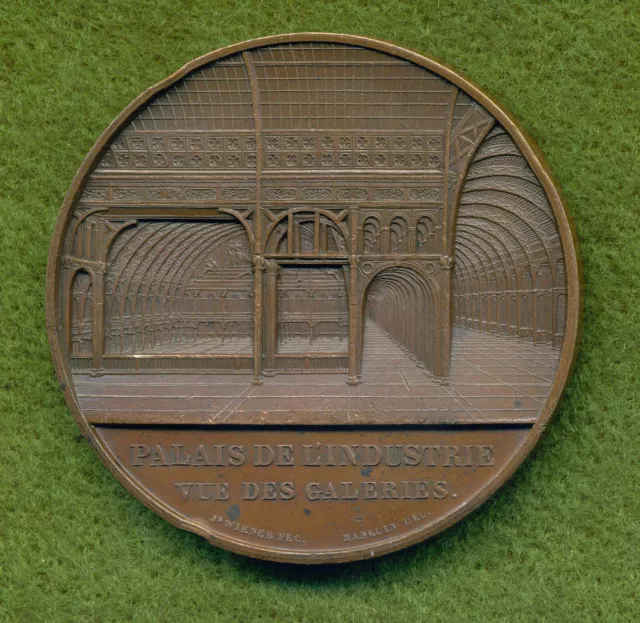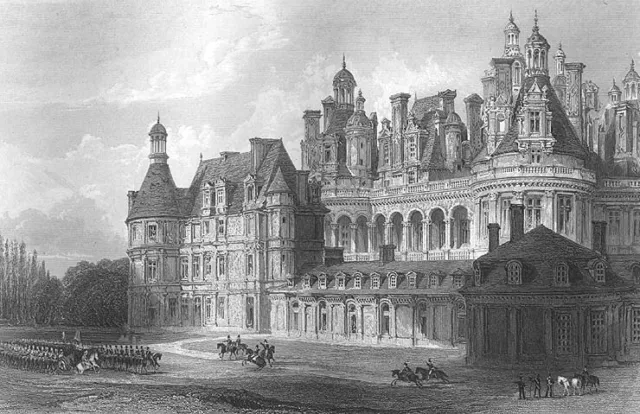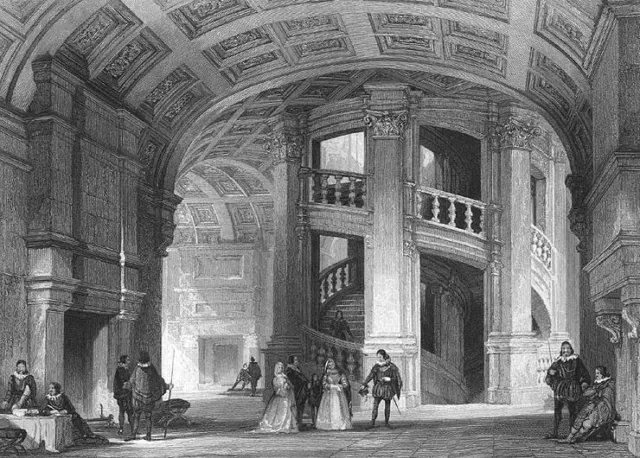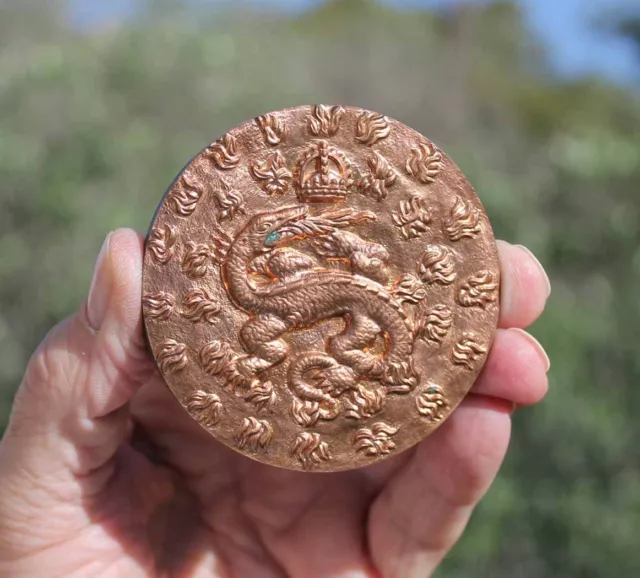France, Chambord, Renaissance architecture, dragon, Coutre
Visit my page with the offers, please.
You will find many interesting items related to this subject.
If you wish to see more medals, click here, please;
France, related to
Historic Battles
Art
This medal has been minted in 1979 in France in to commemorate the Royal residence, Chateau CHAMBORD, France.
This medal has been designed by the outstanding French medalist Marcel COUTRE.
The royal Château de Chambord at Chambord , Loir-et-Cher , France is one of the most recognizable châteaux in the world because of its very distinct French Renaissance architecture which blends traditional French medieval forms with classical Italian structures.
A dragon is a legendary creature , typically with serpentine or otherwise reptilian traits, that feature in the myths of many cultures.
There are two distinct cultural traditions of dragons: the European dragon , derived from European folk traditions and ultimately related to Greek and Middle Eastern mythologies, and the Chinese dragon , with counterparts in Japan, Korea and other East Asian countries. The two traditions may have evolved separately, but have influenced each to a certain extent, particularly with the cross-cultural contact of recent centuries. The English word "dragon" derives from Greek δράκων (drákōn ), "dragon, serpent of huge size, water-snake", which probably comes from the verb δρακε ῖ ν (drakeîn ) "to see clearly".
In the New Testament , the Devil takes the form of a red dragon with seven heads and ten horns, in his battle against Archangel Michael .
av. Château de Chambord
rv. The dragon
diameter - 72 mm, (ca 2⅞“)
weight – 215.70 gr , (7.61 oz) metal – bronze, mint patina
The building, which was never completed, was constructed by King François I in part to be near to his mistress the Comtesse de Thoury, Claude Rohan, wife of Julien de Clermont , a member of a very important family of France, whose domaine, the château de Muides, was adjacent. Her arms figure is carved in the decor of the château.
Chambord is the largest château in the Loire Valley ; it was built to serve as a hunting lodge for François I, who maintained his royal residences at Château de Blois and Château d'Amboise . The original design of the Château de Chambord is attributed, though with several doubts, to Domenico da Cortona . Some authors claim that the French Renaissance architect Philibert Delorme had a considerable role in the château's design, and others have suggested that Leonardo da Vinci may have designed it.
Chambord was altered considerably during the twenty years of its construction, (1519–1547), during which it was overseen on-site by Pierre Nepveu. With the château nearing completion, François showed off his enormous symbol of wealth and power by hosting his old archnemesis, Emperor Charles V at Chambord.
History
François I
Who designed Château Chambord is a matter of controversy. The original design of the Château de Chambord is attributed, though with several doubts, to Domenico da Cortona , whose wooden model for the design survived long enough to be drawn by André Félibien in the 17th century. Some authors, though, claim that the French Renaissance architect Philibert Delorme had a considerable role in the Château's design. In 1913 Marcel Reymond suggested that Leonardo da Vinci a guest of François at Clos Lucé near Amboise, was responsible for the original design, which reflects Leonardo's plans for a château at Romorantin for the King's mother, and his interests in central planning and double helical staircases; the discussion has not yet concluded.
Regardless of who designed the château, on 6 September 1519 François Pombriant was ordered to begin construction of Château Chambord. The work was interrupted by the Italian War of 1521–1526 , and work was slowed by dwindling royal funds and difficulties in laying the structure's foundations. By 1524, the walls were barely above ground level. Building resumed in September 1526, at which point 1,800 workers were employed building the château. At the time of the death of François in 1547, the work had cost 444,070 livres. The château was built to act as a hunting lodge for Francis, however the king spent barely seven weeks there in total, comprising short hunting visits. As the château had been constructed with the purpose of short stays, it was actually not practical to live there on a longer-term basis. The massive rooms, open windows and high ceilings meant heating was impractical. Similarly, as the château was not surrounded by a village or estate, there was no immediate source of food other than game. This meant that all food had to be brought with the group, typically numbering up to 2,000 people at a time.
As a result of all the above, the château was completely unfurnished during this period. All furniture, wall coverings, eating implements and so forth were brought specifically for each hunting trip, a major logistical exercise. It is for this reason that much furniture from the era was built to be disassembled to facilitate transportation. After François died of a heart attack in 1547, the château was not used for almost a century.
Louis XIV
For more than 80 years after the death of King François, French kings abandoned the château, allowing it to fall into decay. Finally, in 1639 King Louis XIII gave it to his brother, Gaston d'Orleans , who saved the château from ruin by carrying out much restoration work. King Louis XIV had the great keep restored and furnished the royal apartments. The king then added a 1,200-horse stable, enabling him to use the château as a hunting lodge and a place to entertain a few weeks each year. Nonetheless, Louis XIV abandoned the château in 1685.
Louis XV
From 1725 to 1733, Stanislas Leszczyński (Stanislas I), the deposed King of Poland and father-in-law of King Louis XV , lived at Chambord. In 1745, as a reward for valour, the king gave the château to Maurice de Saxe , Marshal of France who installed his military regiment there. Maurice de Saxe died in 1750 and once again the colossal château sat empty for many years.
The Comte de Chambord
In 1792, the Revolutionary government ordered the sale of the furnishings; the wall panellings were removed and even floors were taken up and sold for the value of their timber, and, according to M de la Saussaye, the panelled doors were burned to keep the rooms warm during the sales; the empty château was left abandoned until Napoleon Bonaparte gave it to his subordinate, Louis Alexandre Berthier . The château was subsequently purchased from his widow for the infant Duke of Bordeaux, Henri Charles Dieudonné (1820–1883) who took the title Comte de Chambord. A brief attempt at restoration and occupation was made by his grandfather King Charles X (1824–1830) but in 1830 both were exiled. During the Franco-Prussian War , (1870–1871) the château was used as a field hospital.
Dragon
Origin and etymology
The word dragon entered the English language in the early 13th century from Old French dragon , which in turn comes from Latin draconem (nominative draco ) meaning "huge serpent, dragon," from the Greek word δράκων, drakon (genitive drakontos , δράκοντος) "serpent, giant seafish", which is believed to have come from an earlier stem drak- , a stem of derkesthai , "to see clearly," from Proto-Indo-European derk- "to see" or "the one with the (deadly) glance." The Greek and Latin term referred to any great serpent, not necessarily mythological, and this usage was also current in English up to the 18th century.
The association of the serpent with a monstrous opponent overcome by a heroic deity has its roots in the mythology of the Ancient Near East, including Canaanite ( Hebrew , Ugaritic ), Hittite and Mesopotamian . The Chaoskampf motif entered Greek mythology and ultimately Christian mythology, although the serpent motif may already be part of prehistoric Indo-European mythology as well, based on comparative evidence of Indic and Germanic material. It has been speculated that accounts of spitting cobras may be the origin of the myths of fire-breathing dragons.
- Brand: Paris Mint
- Circulated/Uncirculated: Uncirculated
- Composition: Bronze
- Country/Region of Manufacture: France
PicClick Insights - France, Chambord, Renaissance architecture, dragon, Coutre PicClick Exclusive
- Popularity - 1 watcher, 0.0 new watchers per day, 740 days for sale on eBay. Normal amount watching. 0 sold, 1 available.
- Best Price -
- Seller - 4,057+ items sold. 1.8% negative feedback. Great seller with very good positive feedback and over 50 ratings.
People Also Loved PicClick Exclusive

French Art Nouveau medal by Wiener Amazing Paris Exposition Architecture (1855)
£100.40 0 Bids or Buy It Now 5d 10h
Marie Thérèse Countess of Chambord and Henri de France Bronze Medal
£47.39 0 Bids 8d 10h
France, Chateau Chambord, Renaissance architecture, dragon, M. Coutre
£91.46 Buy It Now 8d 3h
1982 French bronze art medal 68mm by coutre Sportiv fishing
£67.45 Buy It Now 28d 4h
France-1715-1774 -Royal Academy Of Architecture - Silver Jeton- Rare
£47.23 Buy It Now 14d 6h 4 watchers
4 watchersChambord Castle French Renaissance architecture Small European Tapestry
£53.97 Buy It Now 3 watchers
3 watchersBlois CHATEAU DE CHAMBORD ~ 1865 Renaissance Architecture Print Engraving RARE!
£43.36 Buy It Now or Best Offer 3 watchers
3 watchersFrance, CHATEAU DE CHAMBORD ~ 1865 Renaissance Architecture Art Print Engraving
£28.90 Buy It Now or Best Offer 3 watchers
3 watchersFrance, CHATEAU DE CHAMBORD RENAISSANCE ARCHITECTURE ~ 1869 Art Print Engraving
£19.27 Buy It Now or Best Offer

